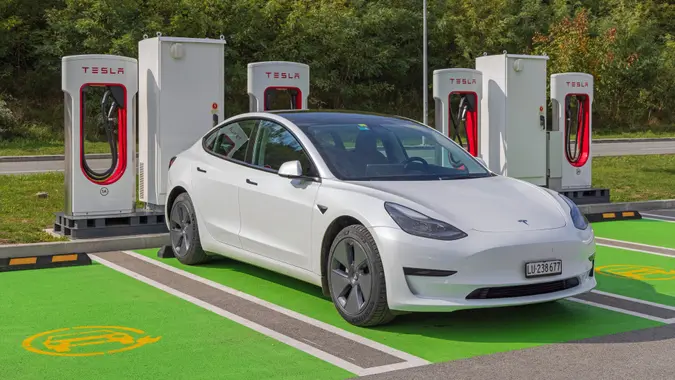I’m a Mechanic: 5 DIY Disasters That Cost Clients Thousands

Commitment to Our Readers
GOBankingRates' editorial team is committed to bringing you unbiased reviews and information. We use data-driven methodologies to evaluate financial products and services - our reviews and ratings are not influenced by advertisers. You can read more about our editorial guidelines and our products and services review methodology.

20 Years
Helping You Live Richer

Reviewed
by Experts

Trusted by
Millions of Readers
Modern cars aren’t the shade-tree repair projects they used to be. The days of simple fixes are over, according to Chris Pyle, mechanic and auto expert from JustAnswer with 25-plus years of experience.
“You could work on your car with little knowledge, few tools and a cheap Haynes repair manual,” Pyle said about working on cars decades ago. “You could park under the limb of an oak tree and use a come-a-long to remove your engine. Those days are gone and replaced by very expensive, highly sophisticated cars with dozens of modules, sensors, solenoids and data communication wiring.”
The stakes are higher now. One wrong move ruins expensive electronics that cost thousands to replace. Here are the DIY disasters Pyle sees most often.
1. Electrical Repairs Using Wire Nuts and Tape
Pyle said he finds wires exposed to weather that have been repaired using wire nuts and electrical tape far too often. The wires get exposed to rain and salt, resulting in corrosion that causes failures throughout the electrical system.
“Wiring repairs on cars should be done by soldering the wires together and heat shrink tubing covering the exposed wires,” Pyle explained. “A DIYer needs to know how to do minor electrical repairs and not cause more problems for a tech to find and fix, resulting in more diagnostics labor time.”
Electrical diagnostics can cost $100 to $150 per hour. Corroded connections cause intermittent problems that take hours to diagnose, running up labor costs while the actual fix might only take minutes.
2. Connecting Jumper Cables or Batteries Wrong
Pyle called this one of the worst issues he deals with. Jumper cables connected wrong, batteries connected backward or a wrench touching both battery terminals causes massive damage.
“What should have been a simple red to + and black to – leaves you with multiple fuses blown, wires burnt and modules cooked,” he said.
Reverse polarity sends voltage through circuits the wrong direction, destroying sensitive electronics instantly. Engine control modules can cost $500 to $1,500. Body control modules can run $300 to $800. Instrument clusters can cost $400 to $1,000. A single mistake can fry three or four modules simultaneously, creating a $2,000 to $5,000 repair bill.
Blown fuses are the cheapest problem at $1 to $5 each, but finding all the damaged fuses and burnt wires takes diagnostic time. Hidden damage might not show up immediately, causing failures weeks later when you’re far from home.
3. Botched Spark Plug Installation
Simple tune-ups turn catastrophic when DIYers cross-thread spark plugs or torque them incorrectly, according to Pyle. “A torque wrench is often not in the toolbox of a DIYer,” he said, noting this results in cylinder heads needing removal or replacement.
Cross-threading a spark plug destroys the threads in the aluminum cylinder head. Thread repair kits cost $50 to $150 but require removing the cylinder head to use properly. Cylinder head removal costs $800 to $1,500 in labor alone. If the threads are damaged beyond repair, cylinder head replacement runs $1,500 to $3,000 including parts and labor.
Over-torquing spark plugs cracks the ceramic insulator or breaks the plug off in the head. Under-torquing lets combustion gases blow past the threads, eroding the aluminum and requiring the same expensive repairs.
A $150 DIY tune-up becomes a $2,000 to $4,000 disaster from improper spark plug installation. Professional shops use calibrated torque wrenches and follow exact specifications to prevent these failures.
4. Oil Change Mistakes That Destroy Engines
Pyle described multiple oil change disasters that cost thousands. Old oil filter gaskets that don’t come off means two gaskets are installed. “They blow out while driving, you lose all your oil and ruin the engine,” he explained.
Engine replacements cost $3,000 to $7,000 depending on the vehicle –all because a DIYer didn’t verify the old gasket came off with the filter, a mistake that takes two seconds to prevent.
Pyle also mentioned over-tightened oil pan drain plugs that ruin threads in the pan, requiring pan repair or replacement. Oil pan replacement costs $200 to $600 in parts plus two to four hours of labor at $100 to $150 per hour.
Using cheap air filters or installing them wrong lets dirty air into the engine. Pyle called this “dusting an engine,” where dirt eats away at cylinder walls and pistons. “You lose compression till eventually the engine has no power,” he said.
Compression loss requires engine rebuilding or replacement. What starts as saving $30 on an oil change ends as a $5,000 engine failure.
5. Using Wrong or Cheap Brake Pads
Pyle warned about using cheap brake pads not designed specifically for your car. The pads are too hard, resulting in high heat, extended braking distance, warped brake rotors and failed calipers.
Warped rotors cost $200 to $400 to replace. Failed calipers run $150 to $300 each plus labor. Extended braking distances create safety hazards that can cause accidents costing thousands more in repairs and insurance increases.
Quality brake pads designed for your specific vehicle cost $50 to $100 more than generic cheap pads. That premium buys proper friction materials, correct thickness and appropriate hardness for your car’s weight and braking system design.
Saving $50 on brake pads can lead to $500 to $1,000 in additional repairs when rotors warp and calipers fail prematurely. Worse, compromised braking performance risks your safety and the safety of other people on the road.
 Written by
Written by  Edited by
Edited by 










































































































